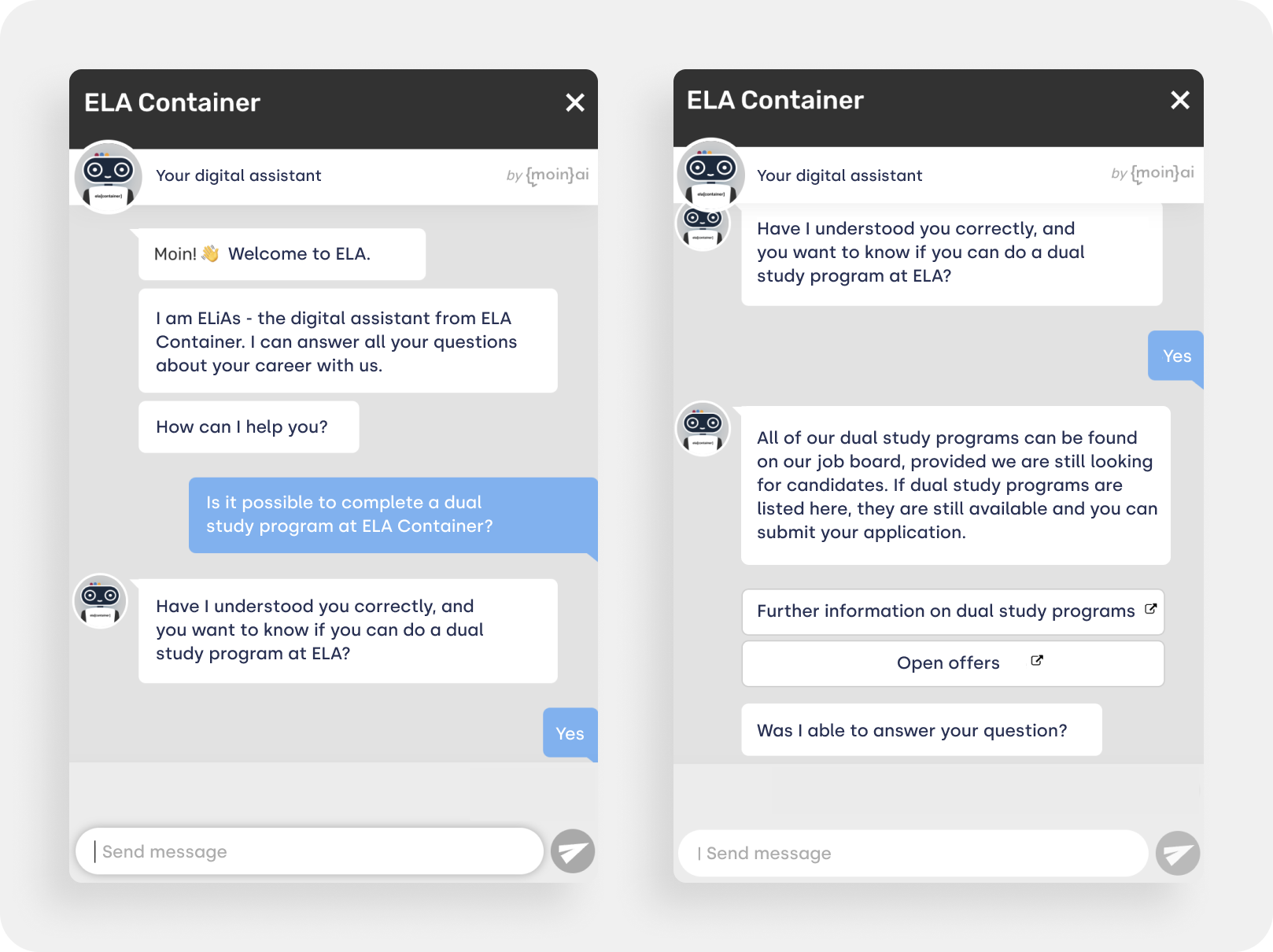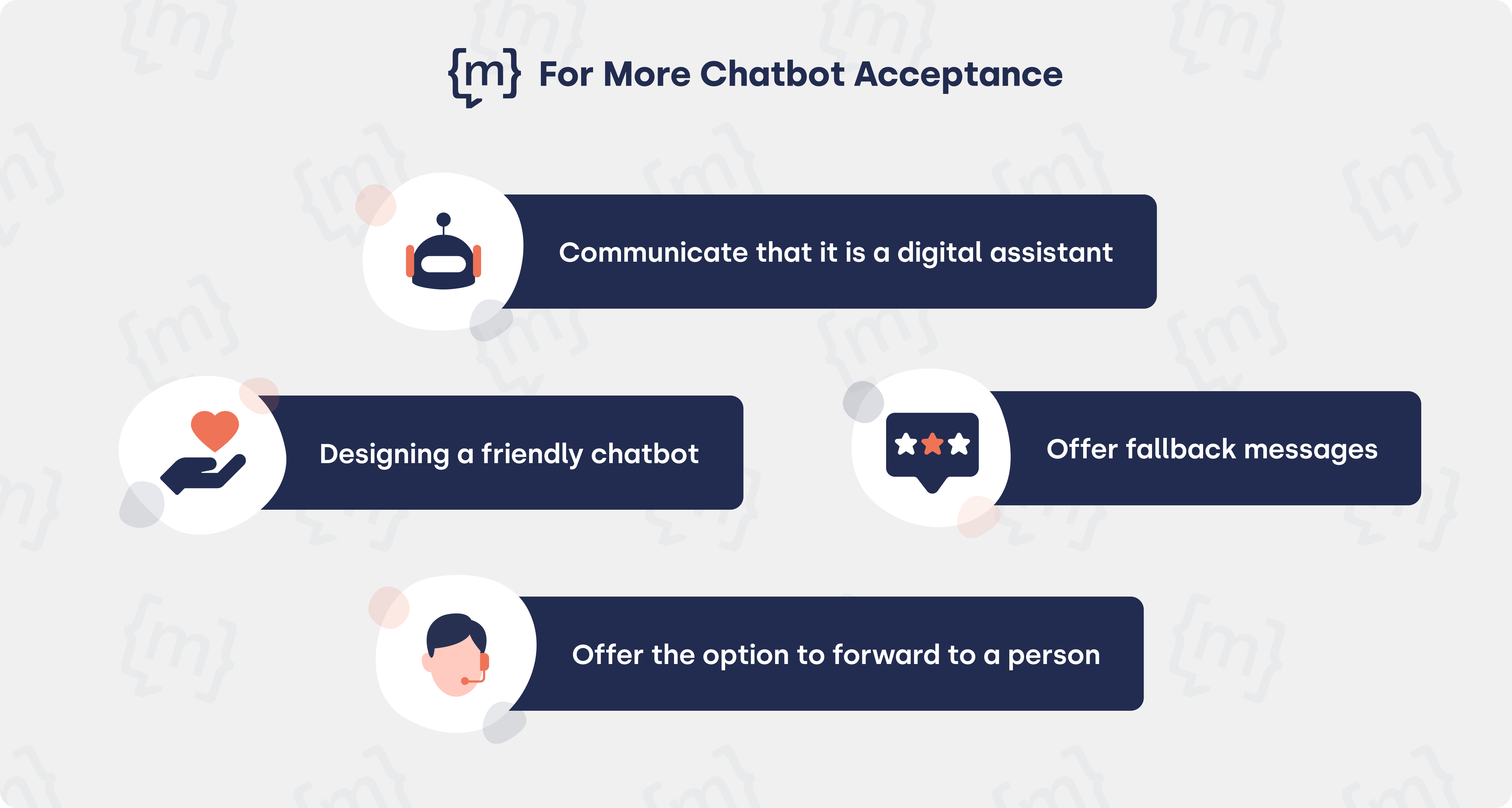What is an HR Chatbot?
An HR chatbot is a software application that enables applicants and employees to have human-like conversations via digital text or voice interfaces. A distinction is usually made between two different types of chatbots:
Rule-Based Chatbots
As the name suggests, this type of chatbot is based on predefined rules that are created and set in advance by software developers. When the chatbot receives a user query, it compares it with its learned rules to generate an appropriate response.
AI-Based Chatbots
An AI-based chatbot, on the other hand, works on the basis of machine learning and natural language processing (NLP). Unlike rule-based chatbots, AI chatbots can understand free text input from users, learn from it, and thus develop automatically.
While rule-based chatbots, also known as “click bots,” are rather simple in design and can therefore be implemented quite quickly, AI chatbots are somewhat more complex to introduce, but can respond to user queries in a much more individualized and targeted manner. The right type of HR chatbot depends primarily on the specific use case.

What are the Areas of Application for Chatbots in HR?
The use of chatbots in HR can be helpful in many different areas for automating administrative tasks, increasing efficiency, and improving user experience and communication. Below are some examples of how chatbots can be used in human resources:
Recruiting and Applicant Management
Chatbots can be integrated into the recruiting process, among other areas, to support applicants during the application process. For example, the bot can respond to questions about job vacancies, provide helpful information about the company, or update the status of an application.
Onboarding and Offboarding of Employees
The use of a chatbot can also be useful in the onboarding and offboarding of employees. New employees often have many questions during the onboarding phase, so the bot can provide information about company policies, processes, and training opportunities, for example. The chatbot can also be useful when employees leave the company by answering questions about severance pay, returning company property, or contract terms.
Employee Management
Not only during the onboarding and offboarding phases, but also in between, questions may arise for employees in their everyday work. Whether it's about topics such as vacation, salary, and benefits, or insurance and personnel policies, the bot can answer questions and respond to requests, thereby reducing the workload for HR staff. In this context, the use of a chatbot would also be conceivable for employee performance evaluations, for example, to send reminders for upcoming performance reviews or to answer questions about goals, feedback, and career opportunities within the company.

Training and continuing education
An important task in human resources is to ensure that employees can develop within the company and expand their skills. In this area, employees may have questions about training programs, professional development, or continuing education events, for example, which the bot can respond to.
As is clear, the possible applications of an HR chatbot are diverse and offer many advantages to both the human resources department and (potential) employees alike. In the following section, you can find out which companies have already successfully integrated and used a chatbot in HR.
Examples of Chatbot Applications in HR
These Companies are Already Using Chatbots in HR
When it comes to chatbot applications, people often think of classic areas of use such as customer service, sales, and marketing. However, internationally renowned companies such as Unilever and Accenture have demonstrated that the use of bots is also worthwhile in HR.
Unilever, a multinational consumer goods company, introduced its chatbot “Unabot” in order to better manage the high volume of applicants: Every year, Unilever receives nearly two million applications for 12,000 different jobs. Now, a large part of the application process has been automated by the chatbot: Applicants first go through a series of online simulations and then conduct a series of online interviews with virtual avatars of company executives. After successfully completing the online stages, there is then a face-to-face interview with managers at Unilever's Discovery Center. Thanks to the digitization of the recruiting process, the HR team's workload is significantly reduced and they can use the time saved more efficiently for other tasks. At the same time, the high quality of applicants can still be maintained.
Accenture, one of the world's largest providers of business and strategy consulting services, has also successfully introduced a chatbot in HR at its India location. The so-called Digital People Adviser, or DiPA for short, primarily supports employees in the onboarding phase by answering questions about Accenture in the area of HR, for example.
Specific Practical Example from moinAI: ELA Container
Another practical example of a company that uses an AI chatbot in human resources and achieves promising results is ELA Container. The internationally active provider of high-quality and flexible room modules employs 900 people in Germany alone. Since January 2023, ELA Container has been using moinAI's AI chatbot solution on its career page to answer frequently asked questions from potential applicants and existing employees.
Topics on which the bot answers questions in English or German include, for example:
- working hours,
- the application process,
- entitlement to a company car,
- the possibility of an internship or a dual study program,
- the interview process,
- benefits, or
- the option to work part-time at ELA Container.
An example conversation with moinAI's chatbot on the ELA Container career page could look like this:

Thanks to the use of chatbots, ELA Container was able to automate 89% of inquiries, significantly improving efficiency in HR. The chatbot has also been well received by users: 75% of the chatbot's responses are rated as positive.
Opportunities and Risks of Chatbots in HR
Opportunities
Relief for the HR Department
A job as an HR professional can sometimes be a challenging balancing act: on the one hand, important company goals must be achieved and numerous administrative tasks completed. On the other hand, employee needs and interpersonal relationships must not be neglected. The fact that HR chatbots can answer recurring questions from employees and applicants means that the HR department saves time, can focus on more complex tasks, and is thus relieved of some of the burden.
Higher Employee Satisfaction
Unlike HR team members, chatbots are available around the clock and can therefore offer support at any time, regardless of location. For example, if an employee falls ill on a Sunday and is unsure of the exact guidelines for sick leave, they can simply ask the HR chatbot.
Optimization of HR Processes
By analyzing interactions with the chatbot, companies gain valuable insights into the most common questions, challenges, and needs of employees. This allows HR policies and processes to be continuously adapted and improved.
Risks
Data Protection and Security
HR topics and questions, such as those relating to pregnancy or salary, are sometimes confidential and highly sensitive. It is therefore advisable to use the chatbot primarily for general topics and to continue discussing individual matters personally with the HR team.
Lack of Acceptance
As always, the golden rule “communication is key” applies: if the company does not clearly communicate the purposes for which a chatbot is being used, employees may become skeptical. To avoid misunderstandings, we recommend defining the specific use case precisely before implementing the chatbot and communicating this transparently within the company.
Lack of Humanity
A chatbot is not intended to replace HR staff, but merely to support them in their daily work. All tasks that require humanity, empathy, and sensitivity should therefore continue to be performed by the HR team. On the other hand, chatbots are always suitable for answering general, recurring questions.
Are Chatbots Better Recruiters?
No, chatbots are not better recruiters.
Chatbots are a valuable addition to the recruitment process, for example, to automate routine tasks and make HR processes more efficient. However, they cannot and should not replace human recruiters. The expertise of an HR professional is particularly important when it comes to soft skills and interpersonal interactions. The ideal solution is therefore a combination of technology and human input in order to leverage the strengths of both.
4 tips for chatbots in HR
Clear Objectives
Regardless of which tool you implement, it is always important to define your expectations and objectives in advance. You should ask yourself in which areas the new technology should be used and what effect it should achieve. In HR, for example, a chatbot can be used specifically for onboarding and offboarding employees. The chatbot is then trained specifically to answer questions that arise in these specific areas. Some time after implementation, surveys can be used to measure whether employee satisfaction has improved as a result.
Adaptation to the Company
Identify the specific challenges facing your company's HR department and customize your chatbot accordingly. There is no “one-size-fits-all” solution for chatbots that works the same for all companies. Instead, it must be clearly tailored to the needs of the company, its employees, and potential applicants in order to create added value.
Communication and Transparency
To ensure that the HR chatbot delivers the desired results, it is essential to communicate internally within the company what the bot is used for and how it works. To this end, it is advisable to provide targeted training for staff and make important information material available. Transparency should be established from the outset, particularly when it comes to data protection and data security, in order to strengthen employees' trust in the chatbot and promote its acceptance.

Continuous improvement
The conversations that the chatbot has with users provide insight into the questions and challenges that your (potential) employees are concerned with. Use this knowledge to continuously optimize your HR processes.
The best providers of HR chatbots
moinAI
moinAI's chatbot, which is based on the latest GPT-4 language model, is versatile thanks to its flexible technology. In the field of HR, the AI-based bot can be used independently of the industry for recruiting, applicant and employee management, as well as for onboarding, offboarding, and training. Since the chatbot is based on artificial intelligence and uses natural language processing, it is constantly expanding its knowledge and can therefore offer employees individual answers to their questions. moinAI's chatbot solution provides an average of 72% automated conversations and can thus contribute significantly to the digitalization of HR processes. Practical features of moinAI include unlimited conversations, industry templates, and the ability to connect to other channels, such as live chat or email.
Haufe HR Assistant
Haufe HR Assistant is a tool from the Haufe Group that is primarily designed to support employees in their day-to-day work. Employees can use HR Assistant to access personal information such as vacation requests, pay slips, performance reviews, and training documents. Haufe HR Assistant can be integrated into Microsoft Teams so that employees can easily submit their requests. However, a free (trial) version of the HR chatbot is not available and no pricing information is provided on the provider's website.
Dialogbird
Another provider of chatbots for human resources is Dialogbird. This can help to drive forward the automation of HR processes and thus relieve the burden on the HR department. The HR tool can be used in areas such as recruiting, onboarding, employment, and offboarding. The chatbot's “editorial tool” function, which allows the HR department to create and maintain content independently, can be tried out as part of a trial access. Dialogbird does not provide any information on its website about whether the chatbot is based on artificial intelligence or not. The software is available from €249 per month.
Conclusion
The use of chatbots in HR offers numerous advantages, as demonstrated not only in theory but also in practice. More and more companies, including successful organizations such as Unilever, Accenture, and ELA Container, are supporting and relieving their HR departments with chatbots, optimizing their HR processes, and increasing employee satisfaction. See for yourself the added value of AI chatbots in HR and recruiting:











